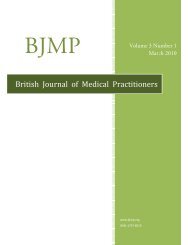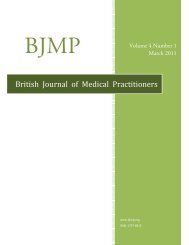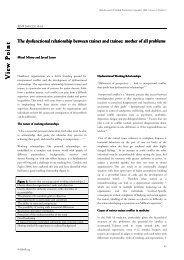R esearch A rticle - British Journal of Medical Practitioners
R esearch A rticle - British Journal of Medical Practitioners
R esearch A rticle - British Journal of Medical Practitioners
Create successful ePaper yourself
Turn your PDF publications into a flip-book with our unique Google optimized e-Paper software.
<strong>British</strong> <strong>Journal</strong> <strong>of</strong> <strong>Medical</strong> <strong>Practitioners</strong>, March 2013, Volume 6, Number 1<br />
Pharmacological Therapies:<br />
Pregabalin: Pregabalin is a gamma aminobutyric acid analogue<br />
which binds to α2δ subunit <strong>of</strong> calcium channels and modulates<br />
them. Its starting dose is 150 mg/day with a maximum dose <strong>of</strong><br />
600 mg/day. As 98% <strong>of</strong> the drug is excreted unchanged in the<br />
urine, its dose is reduced in patients with renal impairment<br />
(creatinine clearance below 60 ml/min) 10 . A Cochrane Database<br />
Systematic Review in 2009 showed that Pregabalin was effective<br />
at daily doses <strong>of</strong> 300 mg, 450 mg and 600 mg, but a daily dose<br />
<strong>of</strong> 150 mg was generally ineffective. The NNT for at least 50%<br />
pain relief for 600 mg daily pregabalin dose compared with<br />
placebo was 5.0 (4.0 to 6.6) for PDN 11 .<br />
Duloxetine: Duloxetine reduces the reuptake <strong>of</strong> serotonin and<br />
noradrenaline at the level <strong>of</strong> spinal cord, thereby potentiating<br />
the descending inhibitory pain pathways to reduce pain. It is<br />
started at a dose <strong>of</strong> 30 mg/day and its dose can be increased to<br />
120mg/day 10 . Sultan et al. in their systematic review found that<br />
pain relief achieved with daily dose <strong>of</strong> 60 mg Duloxetine was<br />
comparable with daily dose <strong>of</strong> 120 mg <strong>of</strong> Duloxetine. The<br />
number needed to treat (NNT) for at least 50% pain relief at<br />
12 to 13 weeks with duloxetine 60 mg versus placebo was 5.8 as<br />
compared to NNT <strong>of</strong> 5.7 for daily dose <strong>of</strong> 120 mg <strong>of</strong><br />
duloxetine. The side effects reported with Duloxetine were<br />
reduction in appetite, nausea, constipation and somnolence 12 .<br />
Systematic Reviews and cohort studies have shown that<br />
duloxetine provides overall savings in terms <strong>of</strong> better health<br />
outcomes and reduction in opioid use, in comparison to<br />
gabapentin and pregabalin, tricyclic antidepressants and<br />
venlafaxine, in pain caused by PDN 13, 14 .<br />
Gabapetin: Gabapentin is structurally related to gammaaminobutyric<br />
acid (GABA) but acts by binding to the alpha2-<br />
delta subunit <strong>of</strong> voltage-gated calcium channels and thereby<br />
reducing the transmission <strong>of</strong> neuronal signals. Gabapentin<br />
bioavailability is non-linear and it tends to decrease with<br />
increasing dose. Gabapentin is not bound to plasma proteins<br />
and has a high volume <strong>of</strong> distribution. It is eliminated<br />
unchanged by the kidneys so in elderly patients and in patients<br />
with impaired renal function, its dose must be reduced.<br />
Gabapentin can be started froma daily dose <strong>of</strong> 300 to 900 mg<br />
and the dose can be increased to a maximum daily dose <strong>of</strong> 3600<br />
mg over 3 weeks period 10 . Gabapentin provides good pain<br />
relief in about one third <strong>of</strong> patients when taken for neuropathic<br />
pain. Adverse events are frequent, but most <strong>of</strong> them are<br />
tolerable 15 .<br />
Tricyclic Antidepressants (TCA): Amitriptyline and<br />
nortriptyline are the commonly used TCA for PDN. They may<br />
be used if there is no benefit from pregabalin or gabapentin and<br />
duloxetine. They may be used alone or in combination with<br />
pregabalin or gabapentin. In small RCTs, amitriptyline has<br />
been found to relieve pain better than placebo in patients with<br />
diabetic neuropathy 10. Amitriptyline is a tricyclic antidepressant<br />
with marked anticholinergic and sedative properties. It increases<br />
the synaptic concentration <strong>of</strong> noradrenaline and serotonin in<br />
the CNS by inhibiting their re-uptake by the pre-synaptic<br />
neuronal membrane. For neuropathic pain it is started at 10-25<br />
mg orally once daily at bed time initially and increased<br />
according to response to a maximum <strong>of</strong> 150 mg/day.<br />
TCA should be used with caution in patients with a history <strong>of</strong><br />
epilepsy, cardiovascular disorders, deranged liver function,<br />
prostatic hypertrophy, history <strong>of</strong> urinary retention, blood<br />
dyscrasias, narrow-angle glaucoma or increased intra-ocular<br />
pressure. It’s other side-effects are agitation, confusion and<br />
postural hypotension in elderly patients 10 . Amitriptyline is the<br />
most studied TCA for DPN and has been compared with<br />
placebo, imipramine, and desipramine. Amitriptyline, when<br />
compared with placebo, reduced pain to a significant degree.<br />
Pain relief was evident as early as the second week <strong>of</strong> therapy,<br />
with greater pain relief noted at higher doses (at a mean dose <strong>of</strong><br />
90 mg). A decrease in pain was not associated with<br />
improvement in mood. A systematic review <strong>of</strong> the TCAs,<br />
including fewer than 200 patients, found no difference in<br />
efficacy between the agents 16 . Nortriptyline is associated with<br />
fewer adverse events than amitriptyline and therefore it should<br />
be preferred in elderly patients.<br />
Opioids: The use <strong>of</strong> opioids in chronic neuropathic pain has<br />
been a topic <strong>of</strong> debate because <strong>of</strong> uncertainty about their<br />
effectiveness, the concerns about addiction problems, the loss <strong>of</strong><br />
efficacy with their long term use due to development <strong>of</strong><br />
tolerance with their long term use and the development <strong>of</strong><br />
hyperalgesia associated with their use. Cochrane review <strong>of</strong><br />
twenty-three trials <strong>of</strong> opiates was carried out. The short-term<br />
studies showed equivocal evidence, while the intermediate-term<br />
studies showed significant efficacy <strong>of</strong> opioids over placebo, in<br />
reducing the intensity <strong>of</strong> neuropathic pain. Adverse events <strong>of</strong><br />
opioids were reported to be common but were not life<br />
threatening. The authors recommended the need for further<br />
randomized controlled trials to establish long-term efficacy,<br />
safety (including addiction potential) and effects on quality <strong>of</strong><br />
life 17 . In RCT Tramadol/Acetaminophen combination was<br />
shown to be associated with significantly greater improvement<br />
than placebo (p < or = 0.05) in reducing pain intensity, sleep<br />
interference and several measures <strong>of</strong> quality <strong>of</strong> life and mood 18 .<br />
In another RCT, controlled release (CR) oxycodone was<br />
compared with placebo, CR oxycodone resulted in significantly<br />
lower mean daily pain, steady pain, brief pain, skin pain, total<br />
pain and disability. In this study the number needed to treat to<br />
obtain one patient with at least 50% pain relief is 2.6 19 .<br />
Gabapentin and morphine combination in randomised<br />
controlled trial showed that the combination <strong>of</strong> the two drugs<br />
provided better analgesia at lower doses <strong>of</strong> each drug than either<br />
<strong>of</strong> the drugs used as a single agent 20 .<br />
Capsaicin: Capsaicin is the active component <strong>of</strong> chilli peppers.<br />
Capsaicin works by releasing the pro-inflammatory mediators<br />
like substance P from the peripheral sensory nerve endings and<br />
thereby causes its depletion from the peripheral nerve.<br />
BJMP.org<br />
14







